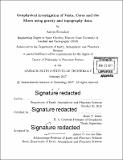| dc.contributor.advisor | Maria T. Zuber. | en_US |
| dc.contributor.author | Ermakov, Anton | en_US |
| dc.contributor.other | Massachusetts Institute of Technology. Department of Earth, Atmospheric, and Planetary Sciences. | en_US |
| dc.date.accessioned | 2017-05-11T19:54:40Z | |
| dc.date.available | 2017-05-11T19:54:40Z | |
| dc.date.copyright | 2017 | en_US |
| dc.date.issued | 2017 | en_US |
| dc.identifier.uri | http://hdl.handle.net/1721.1/108901 | |
| dc.description | Thesis: Ph. D. in Planetary Science, Massachusetts Institute of Technology, Department of Earth, Atmospheric, and Planetary Sciences, 2017. | en_US |
| dc.description | Cataloged from PDF version of thesis. | en_US |
| dc.description | Includes bibliographical references (pages 236-262). | en_US |
| dc.description.abstract | The shape and gravity field are fundamental properties of a planetary body. Combining gravity and topography data sets is, arguably, the most powerful tool to study planetary interiors from orbit. However, even when gravity and topography data are in hand, typically, a wide range of possible geophysical structures is possible. The reader will find that this problem of non-unique solutions permeates all chapters of this thesis. The general strategy to reduce non-uniqueness is to find ways to use additional observations that are sensitive to the interior structure but are not degenerate with gravity and/or topography. In this work, we study three Solar System bodies: asteroid Vesta, dwarf planet Ceres and the Earth's Moon. Using the data from the Dawn spacecraft, we find that once hot and hydrostatic, Vesta is no longer either. It was despun by two giant collisions. We use the Dawn gravity/topography data along with meteoritic data to provide constraints on Vesta's internal structure. Unlike Vesta, Ceres is close to hydrostatic equilibrium. Based on Ceres' topographic spectrum, we conclude that it has experienced limited viscous relaxation. Contrary to the pre-Dawn expectations, we find that the cerean crust is mechanically rock-like. We provide constraints on Ceres' rheology and density structure by combining gravity/topography data with finite-element modeling of lithospheric relaxation. Additionally, we find that Ceres' obliquity undergoes large oscillations, which has important implications for volatile transport. The GRAIL mission has produced gravity models of the Moon with an unprecedented accuracy. We study the spectral content of gravity models and characterize their effective resolution to provide users of these models with the information necessary to understand the model limitations. | en_US |
| dc.description.statementofresponsibility | by Anton Ermakov. | en_US |
| dc.format.extent | 262 pages | en_US |
| dc.language.iso | eng | en_US |
| dc.publisher | Massachusetts Institute of Technology | en_US |
| dc.rights | MIT theses are protected by copyright. They may be viewed, downloaded, or printed from this source but further reproduction or distribution in any format is prohibited without written permission. | en_US |
| dc.rights.uri | http://dspace.mit.edu/handle/1721.1/7582 | en_US |
| dc.subject | Earth, Atmospheric, and Planetary Sciences. | en_US |
| dc.title | Geophysical investigation of Vesta, Ceres and the Moon using gravity and topography data | en_US |
| dc.type | Thesis | en_US |
| dc.description.degree | Ph. D. in Planetary Science | en_US |
| dc.contributor.department | Massachusetts Institute of Technology. Department of Earth, Atmospheric, and Planetary Sciences | |
| dc.identifier.oclc | 986241050 | en_US |
